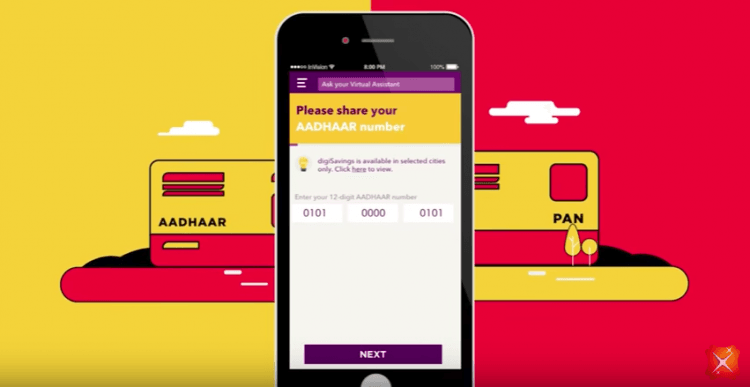
Image credit: 123RF.
In India, customers of Café Coffee Day, a popular chain, can open a Digibank bank account when they pay for coffee. To do so, they need only their biometric-enabled ID card called Aadhaar, and Digibank’s app.
Each cafe outlet has a thumbprint reader for online authentication of customers. After this is confirmed, the bank’s software interfaces with the café’s cash register, captures the information, and opens the bank account.
DBS Bank launched Digibank, a mobile-only bank in India in April last year.
It now has 1.2 million customers and projects that by 2021, it should have five million. That sounds like a lot for a bank that dominates in Singapore’s small market, but it’s still a drop in India’s vast ocean of 1.3 billion people. Nonetheless, the bank is playing a long game in the country.
“As people order coffee, they can also order up a bank. So we’ve massive scale at lower cost,” said DBS Group CIO David Gledhill. Over 500 outlets of Cafe Coffee Day in major Indian cities were involved in this partnership.
The bank accelerated momentum when it teamed up with the Indian conglomerate Reliance which wanted an ewallet to offer such benefits as cashback and reward points to its 100 million customers. DBS white-labelled its ewallet, rebranding it as a Reliance product. But the ewallet has a feature which makes Digibank the mobile bank of choice should a Reliance customer want to open an account.
The partnership route answered a major challenge for DBS: capturing customers digitally. Amplifying this partnership, it embarked on marketing activities to create greater awareness, including sponsoring a major Indian cricket team, Rising Pune Supergiants.
Coupled with its technology strategy, this experience is a guiding light for DBS as it pursues a similar mobile-only bank being piloted in Indonesia.

David Gledhill, CIO, DBS
Being branchless and paperless, Digibank eliminates the costly and onerous form-filling requirement. Using Digibank’s app alone, customers are empowered to open a new account, make payments, transfer money, and undertake other transactions.
Gledhill said the Digibank allowed it to quickly penetrate the retail banking market quickly at one-fifth the cost of setting up a traditional bank.
With tech shaving operating costs, the bank can afford to be more generous with interest payments. Account holders earn 7 percent interest, one of the highest in the market which likely helped it win customers. It also paved the way for better customer engagement.
The artificial intelligence (AI) embedded in the app allows it to respond to customer queries in real-time without the need for human intervention. The AI also helps the bank to learn more about customers’ banking behavior, so the bank can better figure out what services really matter to customers, DBS said in a statement in June this year.
India’s pro-digital environment also aided Digibank’s achievements. Gledhill credits the Aadhaar, a biometric-based ID card that enables speedy authentications online, for facilitating account opening in real-time. More than a billion people in India have the Aadhaar card.
India is ready
Research shows that adoption of smartphones in India is among the fastest in the world. According to the Internet Trends 2017 report by venture capital firm Kleiner Perkins, Caufield & Byers, 80 percent of India’s web traffic is undertaken on mobile devices.
India also had a large population of unbanked and underserved customers. Consulting firm PricewaterhouseCoopers said 233 million people in India in 2015 have never visited a bank.
DBS considered all these factors when it decided that going digital was the only way to scale its business. Opening physical banks would have been costly and taken too long. Acquiring an existing bank to grow was tough as governments generally do not favor foreign ownership of banks. DBS had already suffered a setback when its proposed takeover of Bank Danamon in Indonesia fell through.
“Digital is the only way to go” to grow the bank, said Gledhill as he explains DBS’ ambition to become a stronger regional bank.

However, it was aware that failure was always a possibility and prepared for it accordingly. Throughout Digibank’s nine-month development period, a team experimented with its various aspects, from product features and handling peak transaction periods to app updates and user designs.
The create-and-reiterate process gave the bank a sense of “how acceptable mobile banking would be and a fair sense that it would happen,” said Gledhill.
This process helped define the customer base of the mobile bank, which is the rising affluent and tech-savvy population living in major cities in India, and which would be predisposed to use mobile phones to access the Internet.
It also tempered its app development cycle. Originally, Digibank had planned a weekly update of its mobile app, but Apple generally takes two weeks to approve app updates. So the bank switched to a monthly update schedule.
To ensure smooth transactions, DBS used Amazon Web Services (AWS) cloud infrastructure to provide continual uptime. It was able to migrate its back-end mainframe services to support Digibank in just two weeks.
Competition in India
Digibank does not have mobile banking to itself in India. It has to compete against the payment banks set up by Indian companies Paytm, Airtel, India Post, and Fino whose services are also available via mobile apps. Compared to DBS, which only has 12 branches in India, these payment banks each have hundreds of physical outlets across the country to complement their mobile offerings.
Besides, Digibank may be the only way for DBS to expand in India, said Indian tech blog Trak-in in a report last year. Singapore did not allow Indian banks like State Bank of India and ICICI Bank to expand its reach in the island state, it said, because of a policy under the Comprehensive Economic Cooperation Agreement (CECA).
“As a reciprocal strategy, the Indian Government stopped the expansion of DBS bank into its retail operations in India,” added the report.
Nonetheless, a recent report on the Asia-Pacific banking industry by Ernst & Young points out that “a purely digital bank is particularly attractive to markets with a high mobile penetration and dispersed populations, such as Indonesia, where a new entrant with a strong digital offering could disrupt the market.”
But it also warned of the risk that if too many online-only banks emerge, the business becomes uncompetitive and therefore, unsustainable.
DBS has a long runway after staking an early claim on the mobile-only banking space in Asia, where no other bank has yet ventured. Its digital agenda is already recognized. In July last year, DBS became the first bank to be named World’s Best Digital Bank at the prestigious Euromoney Awards for Excellence. It is the first Asian bank to win the award, pipping global banks ING and Citi.
Gledhill is also the recipient of the prestigious 2017 MIT Sloan CIO Leadership Award presented in May this year. This MIT award recognizes CIOs who deliver exemplary levels of business value through the innovative use of IT.
This post Buy a coffee and open a Digibank account in India appeared first on Tech in Asia.
from Tech in Asia https://www.techinasia.com/buy-coffee-open-digibank-account-india
via IFTTT
No comments:
Post a Comment